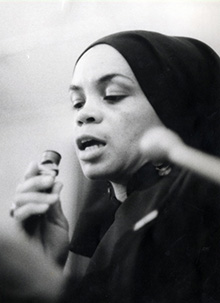As an undergraduate I was lucky enough to be taught by Robert Stone, who was best known for his Vietnam novel, Dog Soldiers, and for his escapades with novelist Ken Kesey and his Merry Pranksters, captured in Tom Wolfe’s The Electric Kool-Aid Acid Test. One afternoon a week, a dozen of us in his fiction-writing class would sit in a seminar room in Johnson Chapel, discussing our stories and monitoring the intense and enigmatic presence of our teacher, who chain-smoked cigarettes as he spoke, the smoke wreathing his head and amplifying the oracular quality of his utterances. Bob’s approach to literature was lofty, his principles summed up in Joseph Conrad’s description, which he recited to us in class, of “the power of the written word to make you hear, to make you feel—before all, to make you see.”
To make you hear, feel and see: it is the writer’s challenge, and Amherst has put its stamp on American literature not only by inviting peerless practitioners to campus, but by teaching literature in a way I can only call profoundly writer-friendly. In the first English class I took at Amherst, English 11, we wrote a lot—short papers, every other class or so, a kind of calisthenics for the writing muscles. More important, the comments on those papers aimed to shake us out of how we had learned to write about literature in high school, that confidently “objective” recitation of big themes, and into something new. Recently I unearthed my old English 11 papers to see how Amherst English remade my way of encountering literature. My teacher, John Cameron, rejected the dutiful trotting-out of literary terminology in my response to a Tennyson poem, advising me to stop being “fussy about imagery, personification, etc” and try instead to “move with the poem—for the sake of the reading.” He wanted me to be less secure, less certain. And more personally invested.
“For the sake of the reading” turns out to be another way of saying, “for the sake of the writing.” How is it, exactly, that one moves with a poem or a passage in a novel? In pinpointing what is so writer-friendly about Amherst, one can trace a line all the way back to Frost and his emphasis on performance and surprise, his insistence that, quoting Hamlet, “the play’s the thing.” All good writing, Amherst English taught, was a performance that captivated and surprised; the challenge in responding to it was not to squash that performance with the steamroller of what my teacher Bill Pritchard called “grad-school English,” but rather to keep it in play a little longer. Good writers were never boring, never dull; why should you be? You had to answer style with style. As he reflected years later in his memoir, English Papers, Pritchard encouraged students to “put a high premium on literary performance as something to admire, both in works of art and in the critic’s sentences about those works.”
The approach was encapsulated in the recurring question put to us in English 11: “What is the experience of reading this passage?” That question baffled at first; but decades later, I can hardly imagine a more apt one. It insists that the essential character of literature is not to be a compilation of themes, not a message or argument or idea, but a work of art. And art is an experience. The point is not to explain what it means, but to engage what it does. For me, as for many other writers educated at Amherst, these were revelations of lasting consequence. Amherst pushed you toward being the kind of reader you needed to be in order to be a writer—the kind who, for better or for worse, was going to be seduced by what Wordsworth called the “grand elementary principle of pleasure … a pure organic pleasure in the lines.”
It’s one thing for a college to use a world-famous writer who once taught there as a kind of brand. But in Frost’s case it’s fair to say that his particular view of literature and art shaped Amherst English for many, many decades. In his pithy 1939 essay “The Figure a Poem Makes,” Frost wryly noted how “scholars and artists thrown together are often annoyed at the puzzle of where they differ” in their approach to poetry. How, he asks, can a poem “have wildness and at the same time a subject that shall be fulfilled”? He answers by asserting that “it should be of the pleasure of a poem itself to tell how it can.”
That seemingly innocent observation has big consequences; it insists that any act of literary art “must be a revelation, or a series of revelations, as much for the poet as for the reader.” To drive home what he meant by this, Frost reached into his magic bag of figurative tricks and pulled out a tantalizing metaphor. “Like a piece of ice on a hot stove the poem must ride on its own melting,” he wrote. “It can never lose its sense of a meaning that once unfolded by surprise as it went.”
Freshness, free play, wildness, surprise. This is what writers live for, what they aim at every time they sit down to work. How lucky we were to learn that at Amherst.












